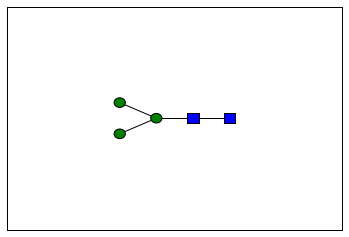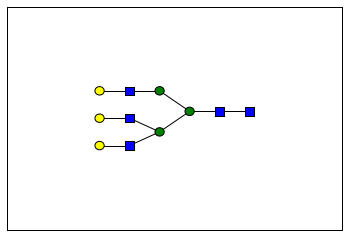glypy Quickstart¶
The basic building block of a glycan is a monosaccharide. Monosaccharides are an extremely diverse family of molecules, but their features are relatively consistent across these variations.
The object-model in glypy is designed to let you specify aspects of
a monosaccharide without placing each carbon by hand, but still allowing
you full control over the gross structure of the object.
import glypy
monosaccharide = glypy.Monosaccharide(anomer='beta', superclass='hex', configuration='d', stem='glc', ring_start=1, ring_end=5)
print(monosaccharide)
monosaccharide.mass()
RES 1b:b-dglc-HEX-1:5
180.0633881022
Behold, Glucose. If you follow the link to MonosaccharideDB, you’ll see that the mass reported is the monoisotopic mass of the monosaccharide.
By default, all sugars are printed out in condensed GlycoCT format.
Here, we’ve made a monosaccharide whose anomeric carbon is in the \(\beta\) configuration, whose backbone contains six carbons, forming a right-handed stereo-structure, with the ring topology of Glucose, starting at carbon 1 and closing at carbon 5.
That was a lot to write for just a molecule of glucose. For convenience, you can also create new common monosaccharides by:
glypy.monosaccharides['Glucose']
RES 1b:b-dglc-HEX-1:5
There is a long list of available names available, some of which are synonyms.
print(glypy.monosaccharides["Glc"])
print('--')
print(glypy.monosaccharides["Glucose"])
print('--')
print(glypy.monosaccharides["bdGlc"])
RES 1b:b-dglc-HEX-1:5
--
RES 1b:b-dglc-HEX-1:5
--
RES 1b:b-dglc-HEX-1:5
Because there are so many names for the same thing, it can sometimes be useful to consult a synonym index or an identity test if you happen upon a name you do not recognize
from glypy.io.nomenclature import synonyms, identity
print(synonyms.monosaccharides['Glc'])
identity.is_a(monosaccharide, "Glucose")
[u'Glucose', u'bdGlc', u'LinearCode:G']
True
Putting Pieces Together¶
monosaccharides = glypy.monosaccharides
glcnac1 = monosaccharides["GlcNAc"]
glcnac2 = monosaccharides["GlcNAc"]
glcnac1.add_monosaccharide(glcnac2, position=4)
bdman = monosaccharides["bdMan"]
glcnac2.add_monosaccharide(bdman, position=4)
adman1 = monosaccharides["adMan"]
bdman.add_monosaccharide(adman1, position=3)
adman2 = monosaccharides["adMan"]
bdman.add_monosaccharide(adman2, position=6)
n_linked_core = glypy.Glycan(root=glcnac1)
print(n_linked_core)
print(n_linked_core.mass())
print(n_linked_core.total_composition())
RES
1b:b-dglc-HEX-1:5
2s:n-acetyl
3b:b-dglc-HEX-1:5
4s:n-acetyl
5b:b-dman-HEX-1:5
6b:a-dman-HEX-1:5
7b:a-dman-HEX-1:5
LIN
1:1d(2+1)2n
2:1o(4+-1)3d
3:3d(2+1)4n
4:3o(4+-1)5d
5:5o(3+-1)7d
6:5o(6+-1)6d
910.327779978
Composition({'H': 58, 'C': 34, 'O': 26, 'N': 2})
What we did here created each monosaccharide unit that composes the core of an N-linked glycan, and connected them together to form a tree or graph structure. Each bond links a parent residue to one of its children in the language of trees, where the first parent is the residue at the reducing end.
At the end, in order to create something aware of the entire tree
structure and not just an individual node in it, we created an instance
of the Glycan class from the first residue, the root of the tree.
To see what we made here, we can look at both a textual representation and an image of the tree
from glypy.plot import plot
%matplotlib inline
plot(n_linked_core)
print(n_linked_core)
RES
1b:b-dglc-HEX-1:5
2s:n-acetyl
3b:b-dglc-HEX-1:5
4s:n-acetyl
5b:b-dman-HEX-1:5
6b:a-dman-HEX-1:5
7b:a-dman-HEX-1:5
LIN
1:1d(2+1)2n
2:1o(4+-1)3d
3:3d(2+1)4n
4:3o(4+-1)5d
5:5o(3+-1)7d
6:5o(6+-1)6d

The process of putting together all of those building blocks can be
repetative as well, so the N-glycan core structure is made available in
glypy.glycans just as glypy.monosaccharides provided a
shortcut for creating individual monosaccharides
premade_core = glypy.glycans['N-Linked Core']
premade_core == n_linked_core
True
Operating on Glycans¶
The real use for this library comes from manipulating glycan structure. We can add and remove monosaccharides, substituents, and modifications per base, derivatize the whole glycan structure, and generate fragments.
Basic operations such as iteration traverse the glycan structure using a depth-first traversal that selects branches by bond order.
accumulated_total_mass = 0
for monosaccharide in n_linked_core:
print(monosaccharide)
print(monosaccharide.mass())
accumulated_total_mass += monosaccharide.mass()
print('-------------')
print(accumulated_total_mass, n_linked_core.mass())
RES 1b:b-dglc-HEX-1:5 2s:n-acetyl LIN 1:1d(2+1)2n
220.082112171
-------------
RES 1b:b-dglc-HEX-1:5 2s:n-acetyl LIN 1:1d(2+1)2n
203.07937252
-------------
RES 1b:b-dman-HEX-1:5
161.044998386
-------------
RES 1b:a-dman-HEX-1:5
163.060648451
-------------
RES 1b:a-dman-HEX-1:5
163.060648451
-------------
(910.32777997822, 910.32777997822)
This shows each distinct monosaccharide unit composing the total structure and their discrete masses after composition loss from forming glycosidic bonds. This total mass is the same as mass of the glycan.
We can traverse the structure in many other ways using the iternodes
function, which is called by the Python iterator
protocol,
__iter__. A feature worth pointing out is that the iternodes
function allows you to pass a callback to influence how it emits
residues. For instance, Glycan.leaves() is implemented similar to
this
import itertools
def leaves(self):
def is_leaf(obj):
if len(list(obj.children())) == 0:
yield obj
return itertools.chain.from_iterable(self.iternodes(apply_fn=is_leaf))
print("The leaf nodes, or `terminal nodes` of the N-linked core")
for leaf in leaves(n_linked_core):
print(leaf)
print('---')
The leaf nodes, or terminal nodes of the N-linked core
RES 1b:a-dman-HEX-1:5
---
RES 1b:a-dman-HEX-1:5
---
As you can see, if you can create a sequence of only nodes that satisfy
some constraint, such as number of child nodes, it is easy to build an
iterator pipeline to perform more complex graph transformations. You can
also iterate over each link in the glycan using Glycan.iterlinks().
This is useful if you want to perform an operation on each Link
object.
Like breaking them.
Glycan Fragmentation¶
A core goal of glypy is supporting flexible glycan fragmentation.
An example of this operation with the N-linked core:
for fragment_ion in n_linked_core.fragments():
print(fragment_ion)
<Fragment kind=Y link_ids=[1] included_nodes=[1] mass=221.089937203>
<Fragment kind=B link_ids=[1] included_nodes=[2, 3, 4, 5] mass=689.237842775>
<Fragment kind=Y link_ids=[2] included_nodes=[2, 1] mass=424.169309723>
<Fragment kind=B link_ids=[2] included_nodes=[3, 4, 5] mass=486.158470255>
<Fragment kind=Y link_ids=[3] included_nodes=[3, 2, 1, 4] mass=748.27495656>
<Fragment kind=B link_ids=[3] included_nodes=[5] mass=162.052823418>
<Fragment kind=Y link_ids=[4] included_nodes=[3, 2, 1, 5] mass=748.27495656>
<Fragment kind=B link_ids=[4] included_nodes=[4] mass=162.052823418>
To connect a fragment to its place in the original structure, you can
retrieve the disjoint sub-trees from a fragmentation by using the
function fragment_to_substructure in the glycan module.
from matplotlib import pyplot as plt
from glypy.structure.glycan import fragment_to_substructure
for links, frags in itertools.groupby(n_linked_core.clone().fragments(), lambda f: f.link_ids):
y_ion, b_ion = frags
y_tree, b_tree = [fragment_to_substructure(frag, n_linked_core) for frag in (y_ion, b_ion)]
fig, axes = plt.subplots(1,2)
b_ax, y_ax = axes
fig.set_size_inches(16, 4)
plot(y_tree, ax=y_ax, center=True)
plot(b_tree, ax=b_ax, center=True)
y_ax.set_title(n_linked_core.name_fragment(y_ion))
b_ax.set_title(n_linked_core.name_fragment(b_ion))
fig.suptitle("Fragments from breaking bond {}".format(links))




The Glycan.fragments() algorithm mutates the object, iteratively as
removing and restoring links between the constituent Monosaccharide
objects. Because we want to use the object’s structure for
fragment_to_substructure, it is important to copy the object before
fragmenting it. All of glypy‘s common structures,
Glycan, Monosaccharide, Link, Substituent, and ReducedEnd have a
clone method.
This is all useful, but what we probably want something more complex than just the core structure to work with. GlycomeDB is the most up-to-date (at the time of this writing) functional Glycomics database. Taking Entry 183, we can get something a little more complicated.
It would be a nuisance to have to manually create each residue, and as
we’ve already seen, glypy knows about GlycoCT
from glypy.io import glycoct
glycomedb183_glycoct = '''
RES
1b:b-dglc-HEX-1:5
2s:n-acetyl
3b:b-dglc-HEX-1:5
4s:n-acetyl
5b:b-dman-HEX-1:5
6b:a-dman-HEX-1:5
7b:b-dglc-HEX-1:5
8s:n-acetyl
9b:b-dgal-HEX-1:5
10b:b-dglc-HEX-1:5
11s:n-acetyl
12b:b-dgal-HEX-1:5
13b:a-dman-HEX-1:5
14b:b-dglc-HEX-1:5
15s:n-acetyl
16b:b-dgal-HEX-1:5
LIN
1:1d(2+1)2n
2:1o(4+1)3d
3:3d(2+1)4n
4:3o(4+1)5d
5:5o(3+1)6d
6:6o(2+1)7d
7:7d(2+1)8n
8:7o(4+1)9d
9:6o(4+1)10d
10:10d(2+1)11n
11:10o(4+1)12d
12:5o(6+1)13d
13:13o(2+1)14d
14:14d(2+1)15n
15:14o(4+1)16d
'''
glycomedb183 = glycoct.loads(glycomedb183_glycoct)
plot(glycomedb183)
glycomedb183
RES
1b:b-dglc-HEX-1:5
2s:n-acetyl
3b:b-dglc-HEX-1:5
4s:n-acetyl
5b:b-dman-HEX-1:5
6b:a-dman-HEX-1:5
7b:b-dglc-HEX-1:5
8s:n-acetyl
9b:b-dgal-HEX-1:5
10b:b-dglc-HEX-1:5
11s:n-acetyl
12b:b-dgal-HEX-1:5
13b:a-dman-HEX-1:5
14b:b-dglc-HEX-1:5
15s:n-acetyl
16b:b-dgal-HEX-1:5
LIN
1:1d(2+1)2n
2:1o(4+1)3d
3:3d(2+1)4n
4:3o(4+1)5d
5:5o(3+1)6d
6:5o(6+1)13d
7:6o(2+1)10d
8:6o(4+1)7d
9:7d(2+1)8n
10:7o(4+1)9d
11:10d(2+1)11n
12:10o(4+1)12d
13:13o(2+1)14d
14:14d(2+1)15n
15:14o(4+1)16d

for links, frags in itertools.groupby(glycomedb183.clone().fragments(), lambda f: f.link_ids):
y_ion, b_ion = frags
y_tree, b_tree = [fragment_to_substructure(frag, glycomedb183) for frag in (y_ion, b_ion)]
fig, axes = plt.subplots(1,2)
b_ax, y_ax = axes
fig.set_size_inches(16, 4)
plot(y_tree, ax=y_ax, center=True)
plot(b_tree, ax=b_ax, center=True)
y_ax.set_title(glycomedb183.name_fragment(y_ion))
b_ax.set_title(glycomedb183.name_fragment(b_ion))
fig.suptitle("Fragments from breaking bond {}".format(links))










Derivatization¶
So this structure is fancier than our last case, but we’re probably not studying it in its native state. Permethylation is a popular technique for glycan analysis in glycan mass spectrometry.
from glypy.composition.composition_transform import derivatize
case = glycomedb183.clone()
print("Clone is identical? {}".format(case == glycomedb183))
derivatize(case, 'methyl')
print("Clone is identical? {}".format(case == glycomedb183))
print("Derivatized Mass: {}, Native Mass: {}, Mass Delta: {}".format(
case.mass(), glycomedb183.mass(), case.mass() - glycomedb183.mass()))
Clone is identical? True
Clone is identical? False
Derivatized Mass: 2496.27212004, Native Mass: 2005.72436779, Mass Delta: 490.547752245